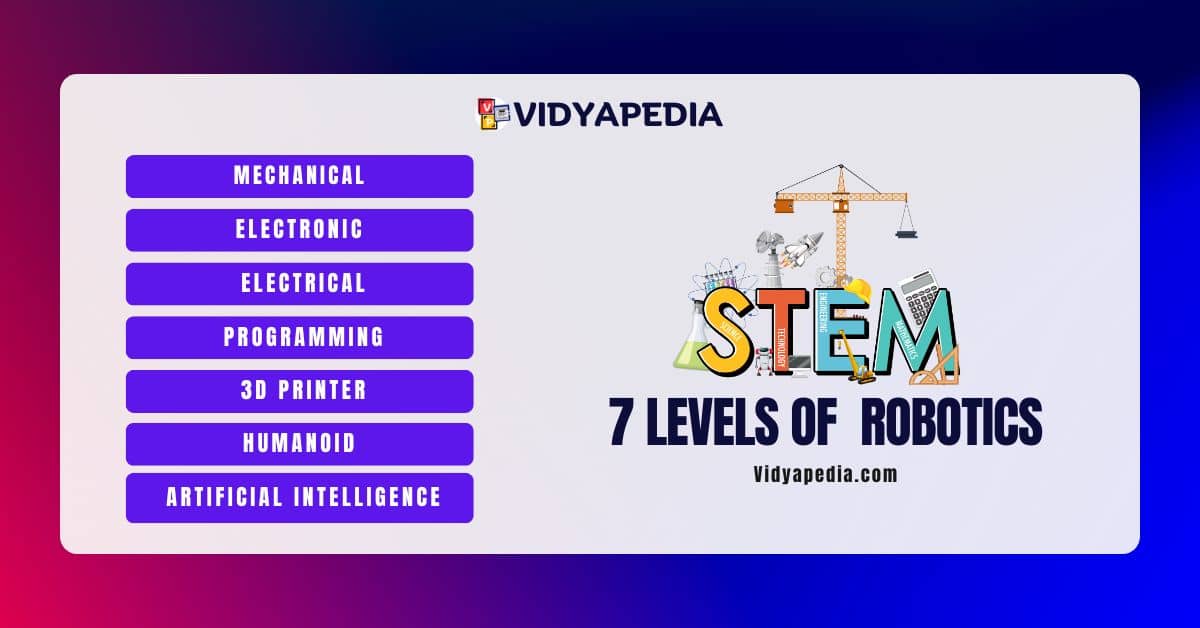Mechanical Level
Beginner:
- Concepts: Basic understanding of mechanical components and simple mechanisms.
- Activities: Building simple mechanical structures using LEGO Mindstorms or VEX IQ kits.
Intermediate:
- Concepts: Introduction to more complex mechanisms, gears, linkages, and structural integrity.
- Activities: designing and assembling robots with moving parts, and understanding torque and force.
Advanced:
- Concepts: Detailed study of kinematics, dynamics, and advanced mechanical systems.
- Activities: Creating custom robots with advanced mechanical designs using tools like CAD software.
Electronic Level
Beginner:
- Concepts: Basic electronics principles, understanding circuits, and components like resistors, capacitors, and LEDs.
- Activities: Building simple circuits with breadboards and basic robotics kits.
Intermediate:
- Concepts: More complex circuit designs, integrating sensors and microcontrollers.
- Activities: Developing robots that respond to sensor inputs and perform more intricate tasks.
Advanced:
- Concepts: Advanced electronics, including PCB design and complex sensor integration.
- Activities: Creating custom electronics for robots, integrating multiple sensors and microcontrollers for complex tasks.
Electrical Level
Beginner:
- Concepts: Basic electrical theory, understanding voltage, current, and power.
- Activities: Simple electrical projects, learning to use multimeters and basic electrical components.
Intermediate:
- Concepts: More advanced electrical concepts, motor control, and power management.
- Activities: Building and controlling robots with different types of motors (DC, stepper, servo).
Advanced:
- Concepts: In-depth study of electrical systems, power electronics, and battery management.
- Activities: Designing and implementing efficient power systems for robots, integrating renewable energy sources.
Programming Level
Beginner:
- Concepts: Basic programming concepts using block-based languages (e.g., Scratch, Blockly).
- Activities: Programming simple robot movements and tasks.
Intermediate:
- Concepts: Introduction to text-based programming languages (e.g., Python, C++).
- Activities: Writing programs for robots to perform complex tasks and respond to sensor inputs.
Advanced:
- Concepts: Advanced programming, including real-time systems and robotics operating systems (e.g., ROS).
- Activities: Developing sophisticated control algorithms and autonomous behaviors.
3D Printing Level
Beginner:
- Concepts: Basic understanding of 3D printing technology and CAD software.
- Activities: Designing and printing simple components for robots.
Intermediate:
- Concepts: More advanced 3D design techniques and printer settings.
- Activities: Creating custom parts for robotics projects, learning to troubleshoot and optimize prints.
Advanced:
- Concepts: Mastering complex 3D printing techniques and multi-material printing.
- Activities: Designing and fabricating entire robot frames and intricate mechanical parts.
Humanoid Level
Beginner:
- Concepts: Basic principles of humanoid robot design and function.
- Activities: Working with simple humanoid robot kits (e.g., small bipedal robots).
Intermediate:
- Concepts: More detailed study of humanoid locomotion and manipulation.
- Activities: Developing and programming robots to perform human-like tasks, such as walking and grasping objects.
Advanced:
- Concepts: Advanced biomechanics, control systems, and human-robot interaction.
- Activities: Building sophisticated humanoid robots with realistic movement and behaviors.
AI (Artificial Intelligence) Level
Beginner:
- Concepts: Basic understanding of artificial intelligence and machine learning concepts.
- Activities: Implementing simple AI algorithms in robotics, such as line following and obstacle avoidance.
Intermediate:
- Concepts: More advanced AI and machine learning techniques, including computer vision and natural language processing.
- Activities: Developing robots that can recognize objects, navigate complex environments, and interact with humans.
Advanced:
- Concepts: Cutting-edge AI research, deep learning, and advanced autonomous systems.
- Activities: Creating robots with high-level cognitive functions, capable of learning from their environment and making complex decisions.
Summary:
- Mechanical Level: From basic mechanical structures to advanced kinematics and dynamics.
- Electronic Level: From simple circuits to advanced sensor integration and PCB design.
- Electrical Level: From basic electrical principles to complex power systems and motor control.
- Programming Level: From block-based coding to advanced robotics operating systems and real-time control.
- 3D Printing Level: From simple component design to complex multi-material printing and complete robot fabrication.
- Humanoid Level: From basic bipedal robots to advanced humanoid biomechanics and human-robot interaction.
- AI Level: From basic AI algorithms to advanced machine learning, deep learning, and autonomous decision-making.


